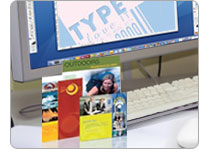- Products
-
Design Templates
- Featured Design Galleries
- More Galleries
- Services & Resources
- Free Sample Kit
- Deals
Graphic design is more than just looking great - it's about helping readers find what they're looking for, displaying important information and motivating a response. Here are five popular design techniques that not only look awesome, but also have wonderful functional attributes

Icons are all the rage today, and that isn't going to change. People are visually driven, so icons act as mental shortcuts for performing certain actions or calling attention to important information. That's why magnifying glasses are used in search bars, light bulbs are used to denote important information, and exclamation point graphics are used to denote critical changes or errors.
When you have a hierarchy of products and services, listing them all under one taxonomy can confuse potential customers. Visual cues such as color coding by base taxonomy can make things far easier to understand at a glance. A lawn care company might offer landscaping services (green), power washing services (blue) and haul-away services (red), for example.
Important information, fields, highlight boxes, and buttons can be framed by using a 1-pixel light-colored line against a 1-pixel dark-colored line and then filling your box in with the base color. This is a useful technique for separating information and drawing attention to critical parts of your design.
Just like frames and shades, text highlights draw attention to crucial information but without the use of graphic elements other than a simple shaded line. Many direct-mail pieces use yellow to highlight key phrases, but you can use any color as long as it is light enough to allow the text to be easily read and dark enough to be seen.
 Today's customers have little time to browse and even less time to make decisions, so big text with clean, compelling copy and simple layouts have more influence than over-designed, cluttered layouts. The goal is to convey the information your customers need to see to make a purchasing decision and then direct them to the purchasing point as quickly as possible. There are literally thousands of design techniques out there, and every designer has his or her own trademark style. Basic design concepts constantly evolve in an effort to stand apart forom the norm and be recognized as such. What works today will not necessarily work tomorrow, and to be revolutionary and innovative you need to come up with your own compelling design techniques. In the meantime, you can bank on the tried-and-true design elements of today to help your clients achieve their sales goals.
Today's customers have little time to browse and even less time to make decisions, so big text with clean, compelling copy and simple layouts have more influence than over-designed, cluttered layouts. The goal is to convey the information your customers need to see to make a purchasing decision and then direct them to the purchasing point as quickly as possible. There are literally thousands of design techniques out there, and every designer has his or her own trademark style. Basic design concepts constantly evolve in an effort to stand apart forom the norm and be recognized as such. What works today will not necessarily work tomorrow, and to be revolutionary and innovative you need to come up with your own compelling design techniques. In the meantime, you can bank on the tried-and-true design elements of today to help your clients achieve their sales goals.